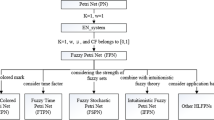Abstract
In the study of weighted fuzzy production rules (WFPRs) reasoning, we often need to consider those rules whose consequences are represented by two or more propositions connected by “AND” or “OR”. To enhance the representation capability of those rules, this paper proposes two types of knowledge representation parameters, namely, the input weight and the output weight, for a rule. A Generalized Fuzzy Petri Net (GFPN) is also presented for WFPR reasoning. Furthermore, this paper gives a similarity measure to improve the evaluation method of WFPRs and the multilevel fuzzy reasoning in which the consequences and their certainty factors are deduced synchronously by using a GFPN.
Similar content being viewed by others
References
Chen SM (1988) A new approach to handling fuzzy decision- making problems. IEEE Trans on Syst Man Cybern SMC-18(6):1012–1016
Chang CL (1985) Introduction to artificial intelligence techniques. JMA Press, Austin, TX
Ribaric S (1988) Knowledge representation scheme based on Petri net theory. Int J Pattern Recognit Artif Intell 2:691–700
Li X, Yu W (2001) Object oriented fuzzy Petri net for complex knowledge system modeling. In: Proceedings of the 2001 IEEE international conference on control applications, pp. 476–481
Li X, Yu W (2000) Dynamic knowledge inference and learning under adaptive fuzzy Petri net Framework. IEEE Trans on Syst Man Cybern 30(4):442–450
Yeung DS, Tsang ECC (1995) A weighted fuzzy production rule evaluation methods. In: Proceedings of 4th IEEE international conference on fuzzy systems, pp. 461–468
Yeung DS, Tsang ECC (1997) Weighted fuzzy production rules. Fuzzy Sets Syst 88(3):298–313
Yeung DS, Tsang ECC (1998) A multi-level weighted fuzzy reasoning algorithm for expert systems. IEEE Trans Syst Man Cybern 28(2):149–158
Chen SM, Ke JS (1990) Knowledge representation using fuzzy Petri nets. IEEE Trans Knowl Data Eng 2(3):311–319
Yeung DS, Tsang ECC (1997) A Comparative study on similarity-based fuzzy reasoning methods. IEEE Trans Syst Man Cybern 27(2):216–227
Tsang ECC, Yeung DS, Lee JWT (2004) Refinement of generated fuzzy production rules by using a fuzzy neural network. IEEE Trans Syst Man Cybern 34(1):409–418
Author information
Authors and Affiliations
Corresponding author
Rights and permissions
About this article
Cite this article
Ha, MH., Li, Y. & Wang, XF. Fuzzy knowledge representation and reasoning using a generalized fuzzy petri net and a similarity measure. Soft Comput 11, 323–327 (2007). https://doi.org/10.1007/s00500-006-0084-4
Published:
Issue Date:
DOI: https://doi.org/10.1007/s00500-006-0084-4




